6 Healthiest Gluten-Free Breads—and 3 To Avoid
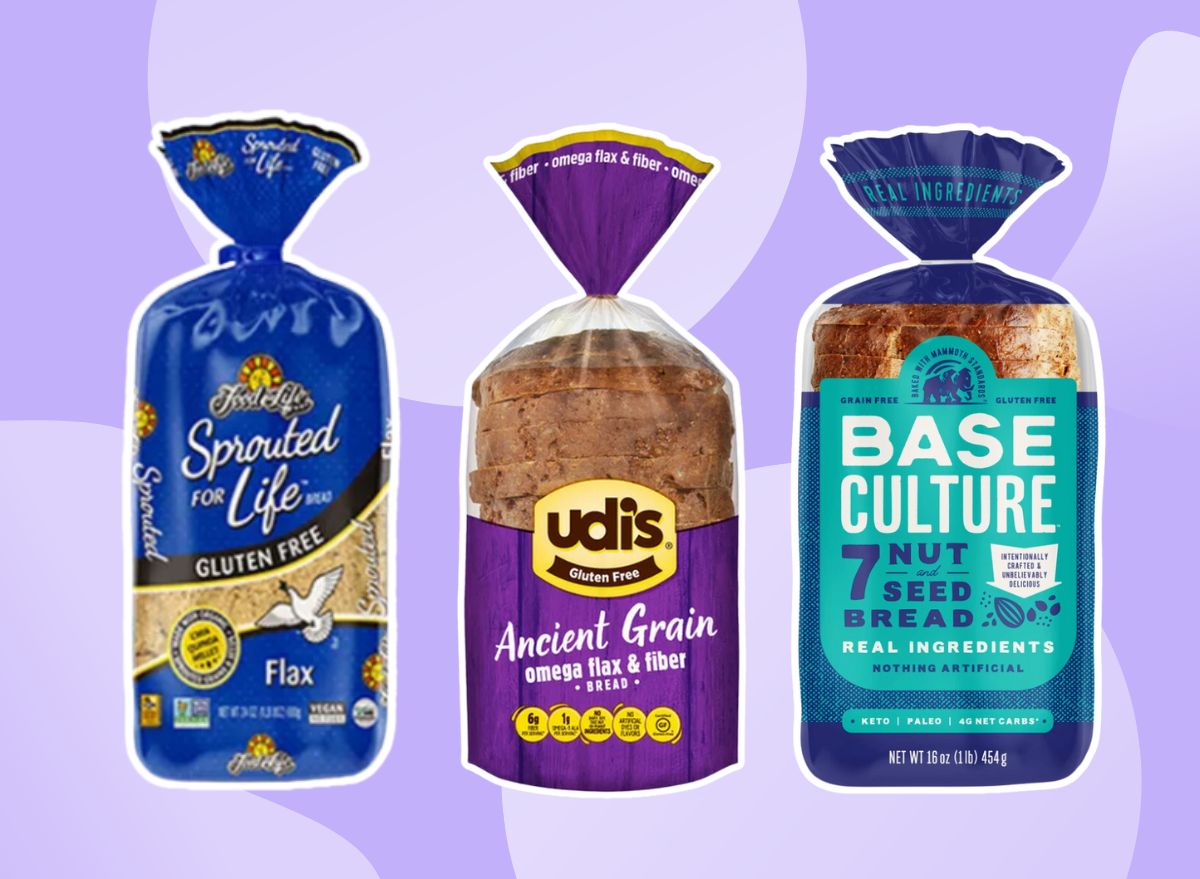
Though some people must avoid gluten because of an underlying health condition, many people choose to follow a gluten-free diet to support their health goals. Gluten is a protein naturally found in grains like wheat, barley, and rye.
People with celiac disease, non-celiac gluten sensitivity, and gluten ataxia must avoid these gluten-containing grains and any foods made with them to prevent serious health problems like malabsorption and malnutrition. Electing to follow a gluten-free diet may benefit health by eliminating unhealthy foods like sugary sweets, salty snacks, and fast food.
However, not all gluten-free products are healthier than the gluten-containing foods they try to replace. Many gluten-free breads are lower in protein and fiber than traditional wheat bread. They also have more fat and sugar. But thanks in large part to the growing popularity of the gluten-free diet, healthier bread options are available for those who avoid gluten.
Keep reading to find out what gluten-free breads are the healthiest choices and what to avoid. Then, check out the 10 Healthiest Store-Bought Breads, According to Dietitians.
How We Chose the Healthiest Gluten-Free Breads
Gluten is an important part of the bread-making process, creating that distinct soft, chewy texture. Bread made without gluten is dense and crumbly and has a gritty texture. Gluten-free bread makers use various ingredients to create a product that’s close in taste and texture to traditional wheat bread. Because they use different ingredients, the nutrition profile and health expectations for gluten-free bread are different than for wheat bread. With this in mind, we used the following criteria to choose the healthiest gluten-free breads:
- Simple, whole food ingredients: We selected gluten-free breads that featured more whole foods ingredients like grains, nuts, and seeds and less refined gluten-free flours. We also looked for bread with few or no artificial ingredients.
- Key nutrients: Gluten-free breads typically have more fat and less protein and fiber than wheat bread. We carefully reviewed the Nutrition Facts label of several gluten-free breads, looking for those with more fiber, more protein, and less fat.
- Gluten-free labeling: According to the FDA, food labeled gluten-free must have less than 20 parts per million of gluten, the lowest amount of gluten detectable in foods using current analytical methods. Though the labeling makes it easier for consumers to find gluten-free items, food makers aren’t required to put “gluten-free” on their labels. We looked for breads labeled gluten-free but didn’t deduct points from products without labels.
6 Healthiest Gluten-Free Breads
Best: Udi’s Ancient Grain Omega Flax and Fiber
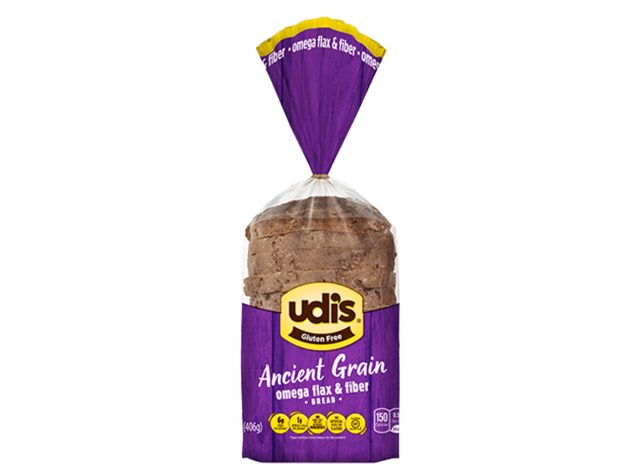
CALORIES: 90
FAT: 3 g (Saturated fat: 0 g)
SODIUM: 135 mg
CARBS: 12g (Fiber: 3 g, Sugar: 1.5 g)
PROTEIN: 2.5 g
Udi’s specializes in gluten-free foods and offers many bread options, but we think Ancient Grain Omega Flax and Fiber is the healthiest choice. The ingredients list features several whole food ingredients including brown rice flour, flax, and chia seeds that contribute to the bread’s fiber content, with each slice meeting 10% of the daily value. It also has 0.5 grams of omega-3 fatty acids as alpha-linolenic acid, an essential fat the body uses to form cell membranes and make cell-signaling molecules.
Udi’s bread is certified gluten-free, which means the bread is independently lab-tested by the Gluten-Free Certification Organization for quality and meets the strictest gluten-free standards. Gluten-free certification isn’t required by the FDA, but it’s a practice that food manufacturers opt to do as an extra layer of safety for their consumers.
Best: Food for Life Sprouted for Life Gluten Free Flax Bread
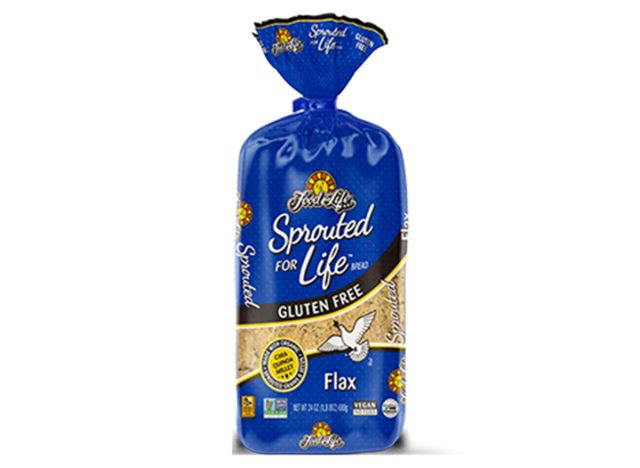
CALORIES: 110
FAT: 2.5 g (Saturated fat: 0 g)
SODIUM: 115 mg
CARBS: 21 g (Fiber: 4 g, Sugar: 1 g)
PROTEIN: 2 g
Food for Life is known for making healthy bread. Though the brand has a few gluten-free options, we think the Gluten Free Flax Bread makes the healthiest choice. It uses quinoa, millet, chia seeds, and flaxseeds to pack in fiber, vitamins, and minerals.
Each slice meets 14% of the daily value for fiber, 10% of the daily value for iron, and 20% of the daily value for zinc. It also provides small amounts of calcium, potassium, folate, phosphorus, magnesium, and manganese.
Food for Life isn’t a gluten-free manufacturer and the bread is made in a facility that also processes wheat, so there’s potential for cross-contamination. People who need to avoid gluten for a health condition like celiac disease may want to avoid foods with cross-contamination to reduce risk of a reaction.
Best: Pacha Buckwheat Loaf Sourdough Bread
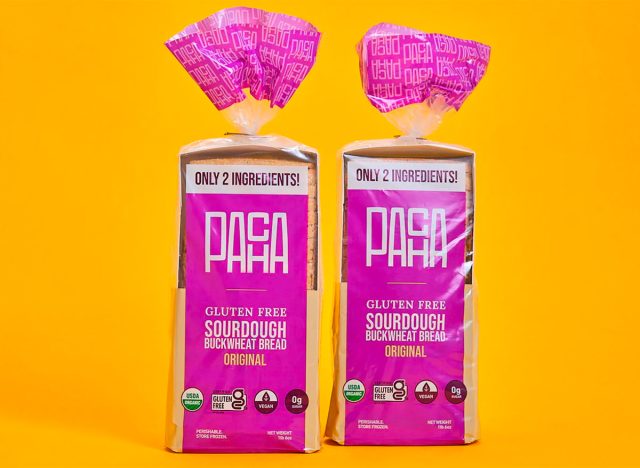
CALORIES: 53
FAT: 0.6 g (Saturated fat: 0 g)
SODIUM: 124 mg
CARBS: 11g (Fiber: 1.5 g, Sugar: 0 g)
PROTEIN: 2 g
With only two ingredients—sprouted buckwheat and sea salt—Pacha Buckwheat Loaf Sourdough Bread makes our list because of its simplicity. It’s also low in calories and fat and has no sugar.
Pacha’s gluten-free bread has less fiber per slice than the other breads on our list, meeting about 6% of the daily value. However, eating two slices provides more fiber and protein—3 grams of fiber and 4 grams of protein—and about the same amount of calories as the other bread on this list.
It’s also GFCO-certified gluten-free and certified USDA organic. We like this gluten-free bread because it’s also free of other common food allergens found in some of the other breads, like eggs and nuts.
Best: AWG Bakery Everyday Loaf
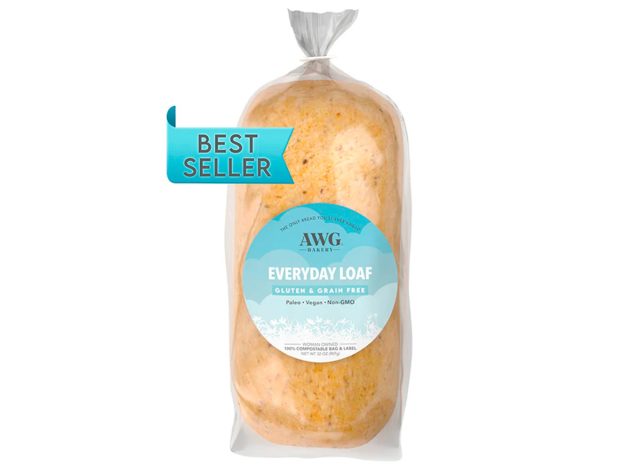
CALORIES: 90
FAT: 3 g (Saturated fat: 0.5 g)
SODIUM: 100 mg
CARBS: 11 g (Fiber: 4 g, Sugar: less than 1 g)
PROTEIN: 2 g
AWG Bakery Everyday Loaf packs a lot of nutrition into bread that’s made without grains, dairy, eggs, or soy. The bread uses a combination of arrowroot flour, almond flour, and coconut flour to create a bread that’s lower in carbs and high in fiber.
Each slice provides 11 grams of carbs and 4 grams of fiber, meeting 14% of the daily value for fiber. Psyllium husk powder and chia seeds help boost the fiber in the bread. The loaf is labeled gluten-free and made with all organic ingredients.
However, because it’s made with coconut flour, it has 0.5 grams of saturated fat, meeting 3% of the daily value. It’s a common misconception that the saturated fat in coconut is healthier than the saturated fat in red meat and high-fat dairy products. However, according to a 2020 study published in the American Heart Association’s scientific journal Circulation, coconut oil consumption leads to higher LDL cholesterol levels—the bad cholesterol that clogs arteries—than vegetable oil, which is something to consider. The bread is unsuitable for people with tree nut allergies.
Best: Base Culture 7 Nut & Seed Bread
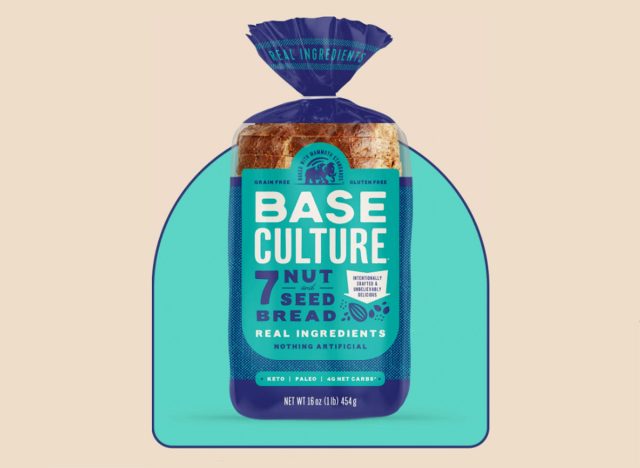
CALORIES: 100
FAT: 7 g (Saturated fat: 1 g)
SODIUM: 160 mg
CARBS: 8 g (Fiber: 4 g, Sugar: 0 g)
PROTEIN: 3 g
As the name implies, Base Culture 7 Nut & Seed Bread uses nuts and seeds, including almond butter, cashews, flaxseeds, pecans, pumpkin seeds, chia seeds, and hemp seeds, to make a nutritious gluten-free bread.
The gluten-free bread packs in the protein with 3 grams per slice, similar to the amount of protein in a slice of wheat bread. It’s also high in fiber, meeting 14% of the daily value, but has more fat and saturated fat than the other gluten-free breads, meeting 9% and 5% of the daily value, respectively.
The grain-free, gluten-free bread is made without artificial ingredients and is GFCO-certified gluten-free, but it is not a good choice for people with tree nut allergies.
Best: BFree Brown Seeded Loaf
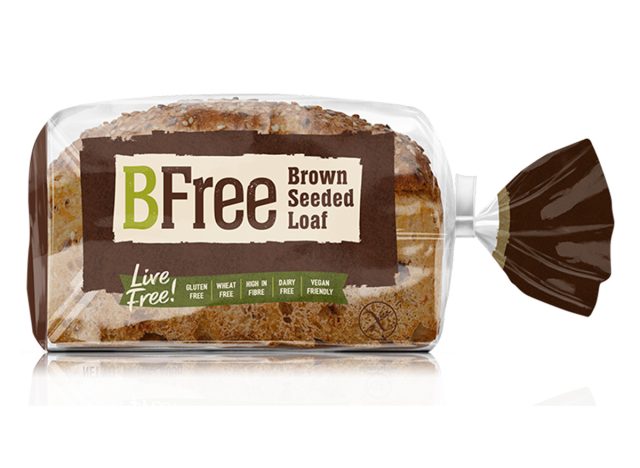
CALORIES: 110
FAT: 4.5 g (Saturated fat: 0.4 g)
SODIUM: 160 mg
CARBS: 15 g (Fiber: 3 g, Sugar: less than 1 g)
PROTEIN: 2 g
Made with a combination of seeds and whole grains, BFree Brown Seeded Loaf is crunchy on the outside and soft on the inside, closely resembling the taste and texture of traditional whole-grain wheat bread.
Key ingredients include whole-grain buckwheat flour, millet flour, rice flour, and flaxseed. Each slice meets 11% of the daily value for fiber and provides trace amounts of iron, potassium, and calcium. The ingredients list includes sugar, but the gluten-free bread has less than 1 gram of added sugar per slice. BFree Brown Seeded Loaf is also GFCO-certified gluten-free.
3 Gluten-Free Breads To Avoid
Worst: Carbonaut White Bread Gluten Free
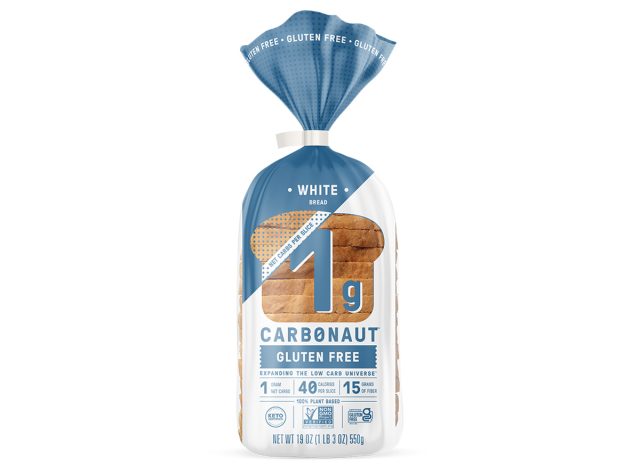
CALORIES: 40
FAT: 2.5 g (Saturated fat: 0 g)
SODIUM: 170 mg
CARBS: 16 g (Fiber: 15 g, Sugar: 0 g)
PROTEIN: 1 g
With 15 grams of fiber per slice, you may think Carbonate Gluten-Free White Bread is on the wrong list. While fiber is a key nutrient we look for in healthy gluten-free bread, the fiber in the Carbonaut bread comes from resistant tapioca starch, resistant potato starch, and inulin. These are isolated fibers extracted from natural sources and added to food to increase fiber content. Though preliminary evidence suggests these fibers may offer health benefits, more studies are needed. Gluten-free breads made with whole grains, seeds, and nuts are a natural source of fiber and make a better choice. Carbonaut’s gluten-free bread is also lower in protein, with 1 gram per slice.
Worst: Eban’s Bakehouse Oatbread
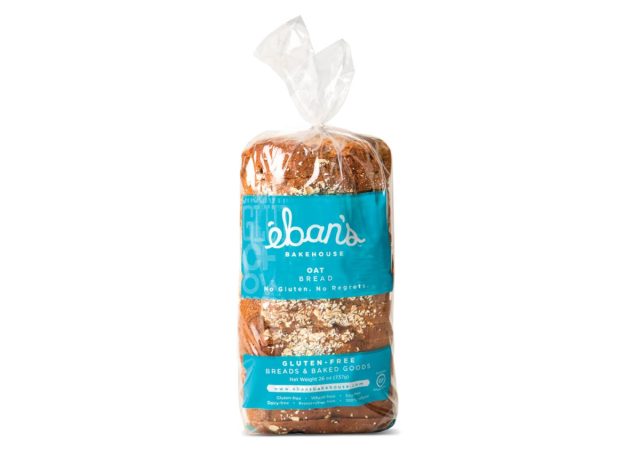
CALORIES: 60
FAT: 1 g (Saturated fat: 0 g)
SODIUM: 130 mg
CARBS: 13 g (Fiber: 1 g, Sugar: 2 g)
PROTEIN: 2 g
We like the short list of ingredients in Eban’s Bakehouse Oatbread and that it’s certified gluten-free, but oat flour is one of the main ingredients in the bread. If you have celiac disease, you may want to avoid this gluten-free bread unless your doctor or registered dietitian says it’s OK for you to eat. Though oats are gluten-free, some people with celiac disease have an adverse immune reaction to the proteins in oats and need to avoid the grain.
Worst: Ener-G Multigrain Loaf (With Brown Rice)
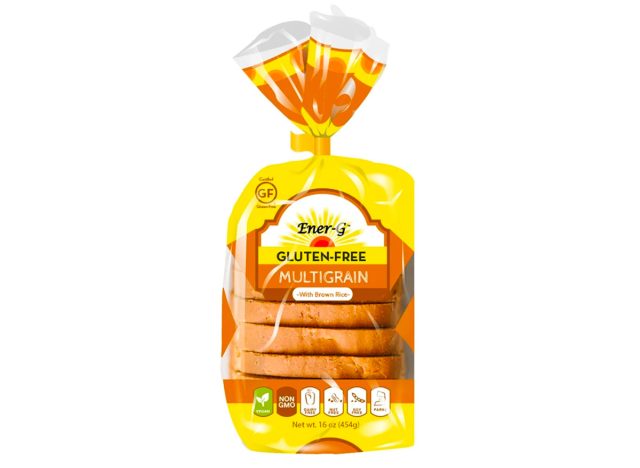
CALORIES: 100
FAT: 5 g (Saturated fat: 1.5 g)
SODIUM: 115 mg
CARBS: 15 g (Fiber: 2 g, Sugar: 3 g)
PROTEIN: 1 g
Ener-G is a well-known gluten-free bakery that offers products like bread, pizza crust, and brownies. The brand has a long history and loyal customers who like enjoying foods like pizza without worry.
However, we were disappointed by Ener-G’s Multigrain Loaf (With Brown Rice) gluten-free bread. Multigrain is a food labeling term that means the product has many grains, not necessarily whole grains, giving the appearance of being a healthy option. The Ener-G bread is made with many grains, including brown rice, amaranth, and millet. However, they’re not the main ingredients in the bread and are listed after tapioca syrup, inverted cane sugar, and pear juice concentrate. It seems that the multigrain bread has more added sugar than grains, making it a less than-healthy choice.
It’s also low in protein, high in saturated fat (8% of the daily value), and has 3 grams of added sugar and a long list of ingredients.
- Source: Jones A. L. (2017). The Gluten-Free Diet: Fad or Necessity?. Diabetes spectrum : a publication of the American Diabetes Association, 30(2), 118–123. https://doi.org/10.2337/ds16-0022
- Source: https://www.niddk.nih.gov/health-information/digestive-diseases/celiac-disease/eating-diet-nutrition
- Source: Khairuddin, M. A. N., & Lasekan, O. (2021). Gluten-Free Cereal Products and Beverages: A Review of Their Health Benefits in the Last Five Years. Foods (Basel, Switzerland), 10(11), 2523. https://doi.org/10.3390/foods10112523
- Source: https://www.fda.gov/food/nutrition-education-resources-materials/gluten-and-food-labeling
- Source: https://ods.od.nih.gov/factsheets/Omega3FattyAcids-HealthProfessional/
- Source: Neelakantan, N., Seah, J. Y. H., & Van Dam, R. M. (2020). The effect of coconut oil consumption on cardiovascular risk factors. Circulation, 141(10), 803–814. https://doi.org/10.1161/circulationaha.119.043052
- Source: https://fdc.nal.usda.gov/fdc-app.html#/food-details/172686/nutrients
- Source: Armet, A. M., Deehan, E. C., Thöne, J. V., Hewko, S. J., & Walter, J. (2020). The Effect of Isolated and Synthetic Dietary Fibers on Markers of Metabolic Diseases in Human Intervention Studies: A Systematic Review. Advances in nutrition (Bethesda, Md.), 11(2), 420–438. https://doi.org/10.1093/advances/nmz074
- Source: Armet, A. M., Deehan, E. C., Thöne, J. V., Hewko, S. J., & Walter, J. (2020). The Effect of Isolated and Synthetic Dietary Fibers on Markers of Metabolic Diseases in Human Intervention Studies: A Systematic Review. Advances in nutrition (Bethesda, Md.), 11(2), 420–438. https://doi.org/10.1093/advances/nmz074









